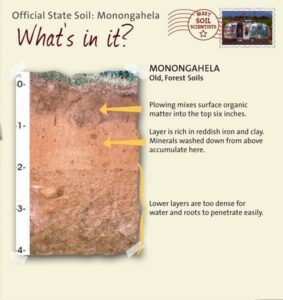What’s Your State Soil?
Every state has a flag. You can probably recognize your state seal and maybe sing the state song. You may know your state’s motto, official flower, or state animal. But do you know your state soil? Yes, all states have a state soil and as of 1997, Monongahela Silt Loam is the official state soil of West Virginia.

This soil type may be the state soil of WV, but Monongahela silt loam was first identified in Greene County, PA in 1921. Named after the Monongahela River, these deep, moderately well drained soils are found on alluvial stream terraces and river valleys not just in West Virginia and Pennsylvania, but throughout Virginia, Tennessee, Ohio, Maryland, Kentucky, and Alabama. This soil derives largely from sandstone and shale which were formed over a millennia ago. It is great crop and pastures soil and considered prime farmland. Monongahela soils can also be used for engineering roads, and buildings. Engineering limitations include structures with basements. These limitations are mainly due to higher clay content in the lower layers, which have the ability to shrink and swell depending on the moisture content of the soil.
Triad’s geotechnical engineering group has a wealth of knowledge and technology to assist in identifying soils at your project site and overcoming soil limitations with engineering practices. Our in-house drilling fleet and on-site soil testing lab support our geotechnical engineers in providing economical solutions to our clients. No matter if your project includes Monongahela soils, Hazleton (the state soil of PA), Sassafras (the state soil of Maryland), or any soil in between, Triad is here to assist. Our geotechnical group is ready to help plan your project, give us a call!
Head over to our Contact Us page to reach out to an office closest to your project location.


